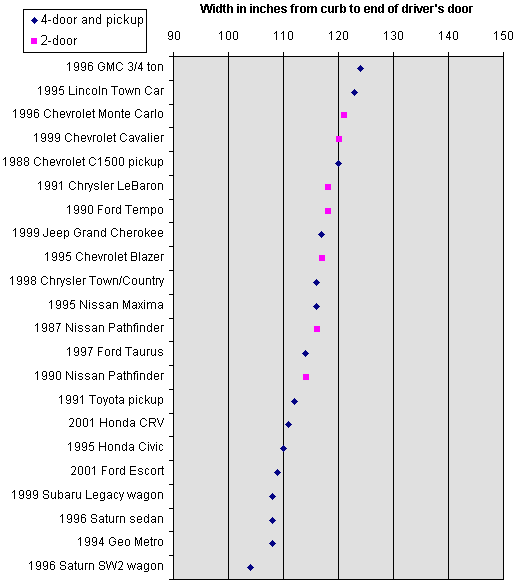JOHN S. ALLEN'S BICYCLE FACILITIES, LAWS AND PROGRAMS PAGES |
||
 |
Top: Home Page Up: Bicycle facilities |
 |
JOHN S. ALLEN'S BICYCLE FACILITIES, LAWS AND PROGRAMS PAGES |
||
 |
Top: Home Page Up: Bicycle facilities |
 |
by John S. Allen
| This article presents measurements of the width occupied by parallel-parked motor
vehicles, an issue of concern in designing roadways for shared use by bicyclists and
motorists. The measurements given below are the sum of the width of the vehicle, the width of the opened driver's door, and six inches of spacing from the curb to the right side of the vehicle. Most of the vehicle width measurements (with door widths) are from manufacturers' specifications, but the maximum width of a vehicle is usually near its midpoint, and so errors are probably small. I have assumed that these measurements do not include side mirrors; those which have been confirmed by direct measurement do not.. The "stick-out" widths of the doors were directly measured for each vehicle. Vehicles typically overhang their wheels by a few inches on each side. Therefore, the right side tires are more nearly 8 inches from the curb than 6 inches to achieve the results shown in the graph below. However, this is a very usual, and lawful, spacing between the curb and the tires. Often, the spacing is greater. The vehicles measured for the graph are of several different styles and sizes, covering nearly the full range of widths among those in common non-commercial use in the USA. However, the sample can not indicate the proportions of different widths of vehicles. Some of the widest and narrowest vehicles, such as the Hummer H2 and the Toyota Prius, have not yet been measured. At normal speeds, a bicyclist can not stop in time to avoid an opening car door. In order to ride predictably, avoiding a sudden swerve -- perhaps into the path of an overtaking motor vehicle -- the bicyclist must choose a line of travel outside the "door zone". Bicycle handlebars are typically 16 inches wide -- though some bicycles have handlebars as much as 24 inches wide for extra leverage when riding on rough terrain. The AASHTO Guide for the Development of Bicycle facilities specifies a minimum of a 5-foot bicycle lane adjacent to a 7-foot parking lane, for a total of 144 inches. A bicyclist must, then, ride with a tire track no more than approximately 10 to 15 inches from the left side of such a lane (130 to 135 inches, or roughly 10 to 10 1/2 feet from the curb); to avoid the risk from car doors -- occasionally merging farther left to overtake the widest vehicles, and to overtake other bicyclists. Various alternatives to the conventional bike lane, for example, the so-called "Denver shared lane symbol," have been proposed in an attempt to avoid encouraging bicyclists to ride too close to car doors. And in some European countries, motorists are drilled to check for bicyclists before opening a car door, and even to open the door with the opposite hand so as to be forced to turn and look back. However, I know of only two measures which are reliably effective: education of bicyclists about how to minimize the actual risks; and elimination of parallel parking. |
Width occupied by selected passenger cars, light trucks,
minivans and SUVS parked 6 inches from right curb,
with driver's door fully open.

| I thank Diane Jacoby, Richard C. Moeur, Fred Oswald and Wayne Pein for their measurements which contributed to this page. |
| Top: Home Page Up: Bicycle facilities Next: Fred Meredith comments |
Contents © 2004, John S. Allen |